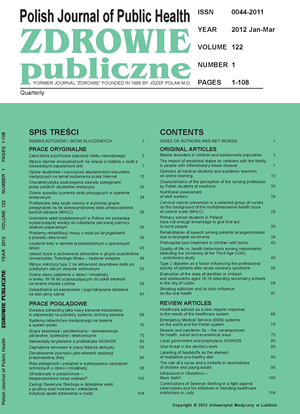Wpływ cukrzycy typu 2 na aktywność zawodową osób po przebytym ostrym zespole wieńcowym
Słowa kluczowe:
cukrzyca typu 2, ostry zespół wieńcowy, epidemiologiaAbstrakt
Wstęp. Cukrzyca typu 2 (Diabetes mellitus typus 2 – DM t.2) jest chorobą cywilizacyjną o charakterze społecznym. wywierająca trudne do przecenienia skutki zdrowotne oraz społeczno-ekonomiczne. Cukrzyca pogarsza przebieg wielu chorób w szczególności chorób układu krążenia.
Cel. Celem naszej pracy było określenie wpływu cukrzycy typu 2 na aktywność zawodową osób, które przebyły ostry zespół wieńcowy (OZW).
Materiał i metody. Badaniami objęto 8640 osób po przebytym OZW (5642 mężczyzn i 2998 kobiet) leczonych w Sanatorium Uzdrowiskowym dla Rolników w Nałęczowie w latach 2005-2009.
Wyniki. Wśród osób z OZW aktywnych zawodowo przed jego wystąpieniem było 50,4% pacjentów z cukrzycą i 56,7% osób bez cukrzycy (p<0,001). W zależności od płci odsetek osób aktywnych zawodowo do wystąpienia OZW wynosił 60,8% mężczyzn z cukrzycą i 61,6% mężczyzn bez cukrzycy (p=0,65) oraz 37,5% kobiet z cukrzycą i 46,7% kobiet bez cukrzycy (p<0,001). Po przebytym OZW aktywnych zawodowo pozostawało 20,1% cukrzyków i 28,8% pacjentów bez cukrzycy (p<0,001). Odpowiednio odsetek ten wśród mężczyzn wynosił 27,9 % w cukrzycy i 35,2% bez cukrzycy (p<0,001), zaś wśród kobiet 10,6% w cukrzycy i 15,7 % nie obciążonych cukrzycą (p<0,001).
Wnioski. Cukrzyca istotnie częściej prowadzi do konieczności zaprzestania aktywności zawodowej u mężczyzn i kobiet po przebytym OZW w porównaniu do osób bez cukrzycy. Pierwotna i wtórna profilaktyka cukrzycy mogłaby przyczynić się do zmniejszenia społecznych kosztów braku aktywności zawodowej u chorych.
Bibliografia
1. Sieradzki J. Cukrzyca. Gdańsk: Via Medica; 2006. p.187-8.
2. Tatoń J, Czech A, Bernas M. Diabetologia kliniczna. Warszawa: Wydawnictwo Lekarskie PZWL; 2008. p.54-64.
3. Bellwon J, Rynkiewicz A. Stan epidemii chorób serca i naczyń. Komu profilaktyka pierwotna, komu wtórna w schorzeniach układu sercowo-naczyniowego? Przewodnik Lekarza. 2009;1(109):43-6.
4. Postuła M, Filipiak K. Zasady rozpoznawania i leczenia choroby niedokrwiennej serca u chorych na cukrzycę. Terapia. 2007;4(192):29-38.
5. Kinalska I, Niewada M, Głogowski C, Krzyżanowska A, Gierczyński J, et all. Koszty cukrzycy typu 2 w Polsce (Badanie CODIP). Diabetol Prakt. 2004;5(1):1-8.
6. Kulik T, Pacian A, Pacian J. Prawne aspekty niepełnosprawności. Zdr Publ. 2008;118(3):348-51.
7. Piechota G, Małkiewicz J, Karwat I. Cukrzyca jako przyczyna niepełnosprawności. Przegl Epidemiol. 2004;58:677-82.
8. Korf M, Katon W, Lin, Simon G, et all. Work disability among individuals with diabetes. Diabetes Care. 2005;28(6):1326-32.
9. Morrish N, Wang S, Stevens L, et all. Mortality and cuases of death in the WHO multinational study of vascular disease in diabetes. Diabetologia. 2001;44(suppl.2):14-21.


